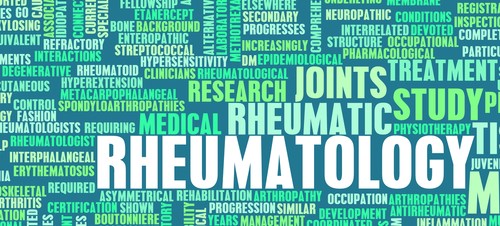Rheumatology is a medical science, which deals with rheumatic disease or musculoskeletal diseases. Rheumatic disease is not a single disorder. Rheumatic diseases encompass more than 200 different diseases, which span from various types of arthritis to osteoporosis and on to systemic connective tissue diseases.
Some people use the word arthritis to refer to all rheumatic diseases. Arthritis, which literally means joint inflammation, is just part of the rheumatic diseases. Arthritis in the restricted sense primarily involves: joint pain, joint stiffness, joint inflammation, and joint damage.
Rheumatic diseases, also called musculoskeletal diseases, are characterized by pain and a consequent reduction in the range of motion and function in one or more areas of the musculoskeletal system; in some diseases there are signs of inflammation: swelling, redness, warmth in the affected areas. Rheumatic diseases can also affect internal organs.
Rheumatism refers to various painful medical conditions, which affect joints, bones, cartilage, tendons, ligaments and muscles.Rheumatic diseases are among the most prevalent. It affects more individuals than any other disease group. In fact a third of people of all ages are affected at some point during their lifetime. Moreover, untreated rheumatic diseases may reduce life expectancy.Rheumatic diseases affect all ages and both genders, although women are more frequently affected than men.Some factors can increase the risk of developing rheumatic disease -Smoking, Excessive weight, Genetic factors, Certain occupations which lead to injury and overuse of joints, Increasing age
You might suspect that you have a rheumatic disease if you have signs and symptoms which include the following: Persistent joint pain, Tenderness, Inflammation indicated by joint swelling, stiffness, redness, and/or warmth, Joint deformity, Loss of range of motion or flexibility in a joint, Extreme fatigue, lack of energy, weakness, or a feeling of malaise.
Assessing the medical history, performing a physical examination or ordering specific laboratory tests, and undertaking imaging investigations, can make a definitive diagnosis of rheumatic diseases.
There is no single medication or treatment, which is optimal for everyone. There are treatment options, which help manage pain and control arthritis symptoms; many inflammatory rheumatic diseases are treated with so-calledDisease modifying drugs which have a more profound impact than drugs, which reduce disease symptoms only; new biologic therapies are among these more effective agents.
Medications are the traditional treatment for arthritis. But there are also: injections into a joint or the soft tissues, natural treatment (acupuncture, chiropractic), alternative medicines and surgical options. Patients vary in theirresponse to treatments for arthritis.
There are several examples of myths and misconceptions about arthritis. These are perpetuated by the spread of inaccurate information and can keep a person away from managing the disease properly. Here are some examples:
Arthritis is an old person's disease. Fact: Arthritis can occur at any age Arthritis is induced by a cold, wet climate. Fact: Climate itself is neither the cause, nor the cure.
Arthritis is caused by a poor diet. Fact: There is little scientific evidence that specific food prevents or causes arthritis, there are few diseases, such as gout, where intake of certain types of food or drinks (alcohol) can precipitate an attack.
The economic burden of rheumatic diseases is very heavy: their cost is estimated at more than 200 billion Euros per year in Europe. According to recent studies, they are the most expensive of all diseases for European health care systems.There is very limited data on health economics from Indian perspective, despite MSK symptoms being most self reported ailment in population study WHO ILAR COPCORD Bhigwan (1996-2014)
If rheumatic diseases are not treated appropriately, daily activities such as walking, climbing stairs, cooking, and personal hygiene are affected. Rheumatic diseases can also have a profound effect on work capacity. They are the single biggest cause of both sick leave and premature retirement, causing physical disability, even amongst people of working age.
Arthritis and arthralgia
Ankle, foot and toe pain
Back pain
Elbow pain
Headache
Hip pain
Knee pain
Muscle pain
Neck pain
Shoulder pain
Wrist, hand and finger pain
Blood test
General test-FBC,UandE, LFT, ESR, CRP, PV, CK, Uric acid, Calcium, Vit D, PTH
Immunology test – RF, CCP, ANA, ENA, Complements, Ig, serum electrophoresis, Urine for BJP, ANCA
Infection blood test- HepB, HepC, HIV, CMV, EBV, Parvovirus, Lyme serology, Rickettsia antibodies
Genetic testing- HLA typing- B27(AS), B52(Bechets), DR4(RA)
Other fluid or tissue Joint fluid- Cell type and count, gram stain and culture, crystal (gout/CPPD), Muscle biopsy, Skin biopsy, Tissue biopsy- LN(sjogrens), Lip, Renal, Chest
Imaging-X ray- hands and Feet, SIJ, Chest and relevant joints,USS,CT- HRCT chest,MRI,MRA,Angiogram,PET CT,Echo,DEXA
Others-PFT,OGD/Colonoscopy,Capsule endoscopy,Hydrogen breadth test
